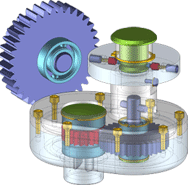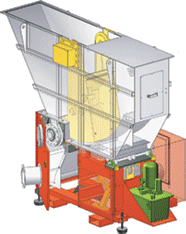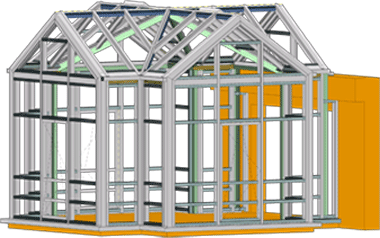Edge and Surface Model
When displaying 3-D parts,HiCAD distinguishes between the edge model and the surface model.
Edge model
Here, the edges of the part are displayed, which conforms to the standards
of technical drawing. Edges can be hidden or visibly highlighted by means
of various settings, in order to facilitate construction. This concerns,
for example, hidden edges (automatic hidden line algorithm), highlighted
edges (edges that form the outline of a part), lateral edges, tangential
transitions etc.
Surface model
The surface model displays the surfaces of the constructed parts in colour
to support the spatial view during construction. The display depends on the colouring and lighting.
In reality, the optical impression of an object is determined by a large
number of characteristics which can scarcely be captured even in complex
calculations (the Gamma Ray tool does this by way of approximation).
A number of assumptions which both simplify handling and speed up calculation
are therefore made with regard to the shading method, also called rendering.
Surface colour
The colour of a surface is a property of the surface alone, i.e. light
is assumed to be "colourless". Depending on the graphic output,
only a limited number of different colours, referred to as a colour table,
is available. The colour is assigned to the surface as a number, and its
mixture of the basic colours of red, green and blue can be varied.
Brightness
The brightness of a surface depends on the lighting and its surface
properties. The following models are provided for the lighting:
- a light source with parallel light beams with infinite range from any direction or
- several point-shaped light sources with different ranges, aperture angles and positions.
The surface is assumed to be flat, i.e. curved surfaces are approximated internally by means of a sequence of flat surfaces. The optical attributes (absorption, reflection etc.) are assumed to be the same for all surfaces and expressed by means of the so-called lighting parameters. Brightness is therefore composed of three contributions.
- Ambient brightness: This contribution is constant and independent of the position and orientation of a surface. This is, for example, the only contribution on the unlit side of a body.
- Brightness from diffuse reflection: This contribution depends on the orientation of the surface in relation to the light source. It is maximal as long as the surface is illuminated perpendicularly and disappears when the surface is turned away from the light source.
- Brightness from specular reflection: This contribution depends on the orientation of the surface in relation to the light source and the viewer. It is maximal if the light is refelected directly to the viewer. This gives rise to shimmer spots on curved surfaces.
Transparency
If a part is created as transparent (layer=40), its surfaces are only
filled "incompletely", with the result that surfaces below shine
through.
Shading type
To speed up brightness calculations, various shading types are made
available:
- Flat: Brightness is calculated only at one point for each (flat) surface and then transferred to all others. This calculation is quick, but does not create any nuances within a surface.
- Gouraud: Brightness is calculated at every surface point and interpolated in between. The shading within a surface blurs transitions between surfaces that are weakly inclined to one another, i.e. achieves "fillets".

Representation of Views (3-D) • View Functions (3-D) • Material and Lighting (3-D)




